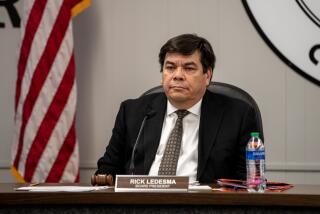Status Quo Resumes in Orange
- Share via
Orange teachers returned to work Friday with a profound sense of ambivalence--proud about a one-day strike that kept most instructors home, but still nagged by uncertainty and anger about their futures.
Now what? Thursday’s strike kept between 60% and 70% of teachers home. But the costs--fiscal and emotional--were still mounting. And healing seemed a distant mirage.
Teachers in the 29,000-student Orange Unified School District were still being paid well below the county median. School trustees still were insisting they can’t afford both higher salaries and lifetime medical benefits for veteran teachers.
A gulf of bitterness still divided instructors and elected trustees over a contract the district unilaterally imposed last month. Contract talks for the last two school years and the upcoming one were still at a standstill.
Nonetheless, on Friday, all teachers who were supposed to be at work were there. Students were back as well. Three schools--West Orange Elementary, Yorba Middle and Richland High--experienced double the normal student absentee rate, district spokeswoman Judith Frutig said.
“I’m glad to be back in my classroom,” said sixth-grade teacher Andrew Matos at Esplanade Elementary as he tried to contend with the mixed emotions of a strike. “I never wanted to strike, but I felt we had to. I urged us to go on strike. . . . It’s kind of like being in an abusive relationship. Unless you stand up for yourself, it’s going to get worse.”
While taking his stand, Matos also may be making his move. His resume is out, and he isn’t sure he’ll return for a sixth year of employment at Orange Unified.
Much about the one-day teachers strike was hard to gauge. But the district shelled out $250 each for 802 substitutes, for a total of $200,500. Because striking teachers were docked pay--they earn between $178 and $305 a day--Orange Unified figures it broke even on staffing costs, Frutig said. There won’t be a final tally until next week, and that tab will include fees for posting at least one private security guard at each of the district’s 42 campuses.
James A. Bowles, the district’s chief negotiator, said the work action had little effect other than disrupting a school day.
“A one-day strike doesn’t change the dynamics of the bargaining--each side still has its position,” Bowles, a lawyer, said. “I always say you have to resolve these things at the bargaining table; they’re not resolved on the picket line.”
On Friday, trustees either declined or did not respond to a request for comment on the strike aftermath.
District officials, however, said they would welcome teachers back to the table to discuss a contract for next year. But teachers union official Bill Shanahan said they won’t discuss next year until the district lifts the contract it imposed in March.
The Orange Unified Education Assn. has lodged a charge of unfair labor practices over that action. But it could take several years for that complaint to be adjudicated by the Public Employment Relations Board and the courts, if necessary.
The contested contract, giving a retroactive 8% raise over two years, piqued union members because it was a one-sided action and it still doesn’t bring instructors up to the county’s median teacher pay. School trustees have said they had little choice but to act unilaterally because talks were stalled and recruitment efforts suffered from low salaries.
Teachers on Friday received their first post-raise paychecks. Two described the boost as a pittance.
About 1,330 teachers missed work Thursday--60% by the district’s count, 70% by the union’s reckoning. Some district officials questioned the depth of teachers’ support for their own union. But union officials viewed the turnout as strong, considering how many Orange teachers are not yet tenured.
“It’s certainly not an overwhelming endorsement by the teachers,” said Jerry Hayward, co-director of the Policy Analysis for California Education think tank. “But the fact that it’s over half means the board shouldn’t be looking at this as a victory either.”
Kent Wong, a labor attorney and director of UCLA’s Center for Labor Research and Education, described the turnout as “considerable.”
“You can’t run a school with 60% of the teachers not there,” Wong said. “Orange County is not known as a center of labor activism, so the fact that 60% participated is significant. . . . A strike is a very strong statement and one that’s not easy to obtain mobilization and support from all of the employees.”
The district and union have long had a stormy relationship. Contract talks have lurched and sputtered for two years, and the sides are separated by a chasm of mutual distrust.
Many teachers believe the board is more conservative than the admittedly conservative community--despite the fact that the voters elected the trustees. Some suspect trustees want to weaken public education--a charge trustees dispute. Likewise, some trustees see the union as an institution to the left of Orange residents. They say they are restoring fiscal security to a district where previous, more liberal boards kowtowed to union demands despite the cost.
Although the strike didn’t force a new bargaining session or another contract offer, some teachers believed it raised public awareness of their plight. Others hoped the public will be incensed enough to intervene--possibly by recalling trustees.
“The public now realizes that the teachers are underpaid compared to other school districts, and the public is a lot more aware of some of the problems [the district] faces,” said Wayne Johnson, president of the California Teachers Assn. “[The strike] cast a very bright light on that board, and what I consider their irresponsible running of that district.”
Staff writer Ann L. Kim contributed to this report.
More to Read
Sign up for Essential California
The most important California stories and recommendations in your inbox every morning.
You may occasionally receive promotional content from the Los Angeles Times.













